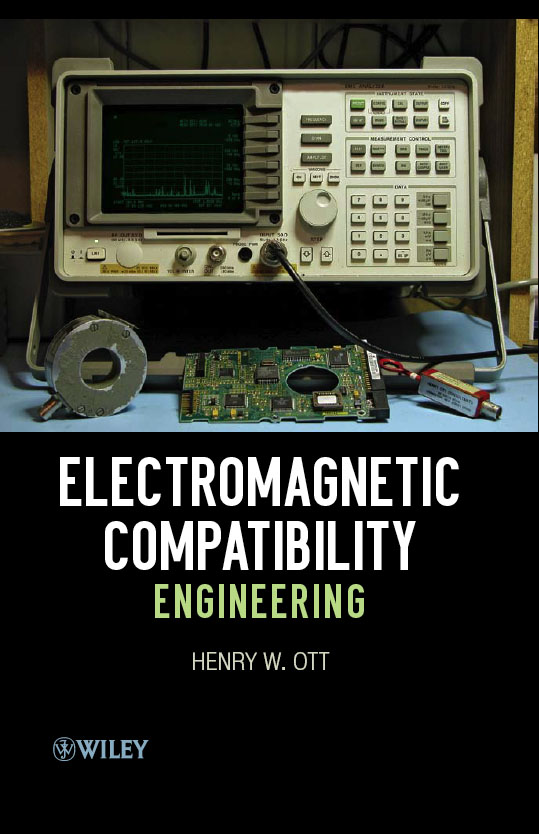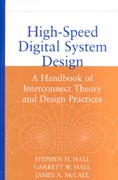Henry Ott Consultants
Electromagnetic Compatibility Consulting and Training
Three Book EMC/Signal Integrity Library
Paid Amazon Links Provided
Would you like to have a mini-library on EMC and Signal
Integrity that covers the frequency range from DC to light (well almost
--- it actually goes to 10's of GHz)? The following three books,
all highly recommended, will accomplish that. All the books are very
practical with a minimum amount of mathematics, and there is very little
overlap between the material contained in each of the books. I use
all three of the books regularly. The three books are:
The books should be read in the order listed.
Not only are all three books very readable, but they are also very
useful
to use as a reference when designing. You can just pick one up
and
look at the section of particular interest. The first book is
about 900 pages, the second 450 pages, and the third 350
pages.
 The
Ott
book (2009) is considered by many to be "the bible on EMC." It is the most comprehensive book on the subject and is the
first EMC book you should read. It is a complete rewrite and expansion of the author's best selling book Noise Reduction Techniques in Electronic Systems, 2nd Edition.
In addition to the core subjects of
cabling, grounding, balancing, filtering and, shielding that made the
author's previous book such a wide success, this new book includes
additional coverage of equipment and system grounding, switching power
supplies and variable speed motor drives, digital circuit power
didtribution and decoupling, PCB layout and stackup, mixed-signal PCB
layout, rf and transient immunity, power line disturbances and,
precompliance EMC measurements. In addition there are new appendices on
dipole antennas, the theory of partial inductance, and the ten most
common EMC problems. Written in the author's easy to read and
understand style, it's full of real-life practical examples. In
addition the characteristics of passive components, contact protection,
intrinsic noise sources, active device noise, and electrostatic
discharge
are all discussed. Each
chapter contains problems for the reader to work out (251 in all), with
answers included in the appendix as well as a list of extensive
references. The book also has an
extensive index which makes finding what you want easy. This book
contains 18 chapters, 6 appendices, 566 figures, and 872 pages.
This book won the 2009 "Prose Award" for the best book published in the category of "Engineering & Technology" published in 2009.
The
Ott
book (2009) is considered by many to be "the bible on EMC." It is the most comprehensive book on the subject and is the
first EMC book you should read. It is a complete rewrite and expansion of the author's best selling book Noise Reduction Techniques in Electronic Systems, 2nd Edition.
In addition to the core subjects of
cabling, grounding, balancing, filtering and, shielding that made the
author's previous book such a wide success, this new book includes
additional coverage of equipment and system grounding, switching power
supplies and variable speed motor drives, digital circuit power
didtribution and decoupling, PCB layout and stackup, mixed-signal PCB
layout, rf and transient immunity, power line disturbances and,
precompliance EMC measurements. In addition there are new appendices on
dipole antennas, the theory of partial inductance, and the ten most
common EMC problems. Written in the author's easy to read and
understand style, it's full of real-life practical examples. In
addition the characteristics of passive components, contact protection,
intrinsic noise sources, active device noise, and electrostatic
discharge
are all discussed. Each
chapter contains problems for the reader to work out (251 in all), with
answers included in the appendix as well as a list of extensive
references. The book also has an
extensive index which makes finding what you want easy. This book
contains 18 chapters, 6 appendices, 566 figures, and 872 pages.
This book won the 2009 "Prose Award" for the best book published in the category of "Engineering & Technology" published in 2009.
 The
Johnson
& Graham book (1993) picks up where the Ott books leaves off with respect
to high-speed digital circuits. Despite it's title this is more an
EMC book than a classical digital design book. Its subtitle,
"A Handbook of Black Magic," gives away its true focus. Besides containing
much practical information on the EMC aspects of high-speed digital design
the book also contains useful information on various measurement techniques
that can be used to measure such things as power-ground plane impedance,
metastable states, etc. Subjects include chapters on transmission
lines, terminations, vias, clock distribution, clock oscillators, ribbon
cables and connectors, layer stack-up, and power distribution. Many
subjects covered relate to signal integrity issues as well, such
as transmission lines, clock skew and jitter, terminations, vias, etc.
The book is considered by many as a "crossover book" covering both EMC
and signal integrity issues. Everything in the book is easy to read
and practical. This is a "must have" book if you are designing high-speed
digital circuits. This book contains twelve chapters, three appendices,
and contains 447 pages.
The
Johnson
& Graham book (1993) picks up where the Ott books leaves off with respect
to high-speed digital circuits. Despite it's title this is more an
EMC book than a classical digital design book. Its subtitle,
"A Handbook of Black Magic," gives away its true focus. Besides containing
much practical information on the EMC aspects of high-speed digital design
the book also contains useful information on various measurement techniques
that can be used to measure such things as power-ground plane impedance,
metastable states, etc. Subjects include chapters on transmission
lines, terminations, vias, clock distribution, clock oscillators, ribbon
cables and connectors, layer stack-up, and power distribution. Many
subjects covered relate to signal integrity issues as well, such
as transmission lines, clock skew and jitter, terminations, vias, etc.
The book is considered by many as a "crossover book" covering both EMC
and signal integrity issues. Everything in the book is easy to read
and practical. This is a "must have" book if you are designing high-speed
digital circuits. This book contains twelve chapters, three appendices,
and contains 447 pages.
 The
Hall,
Hall, & McCall book (2000) continues where the Johnson and Graham book
ends. This book is a signal integrity book. It is well written
with a good balance between theory and practical applications. The
first sentence of the book sets the tone of the book, it reads, "The
speed of light is just too slow." Subjects include transmission line
considerations, crosstalk, IC package and pin-out considerations , power
delivery and decoupling, non ideal current return paths, simultaneous switching
noise, timing and skew considerations, and radiation. The book also
includes a chapter on design methodologies useful in the design of high-speed
systems with a very large number of variables. This chapter attempts to
make an intractable problem tractable. As does the Johnson
& Graham book, this book also contains a chapter on high-speed measurement
techniques. The information contained in this book is useful at both the
chip as well as the PCB level. Although some of the subjects covered
in this book are the same as the Johnson & Graham book there is very
little overlap in the actual material. This book contains eleven
chapters, six appendices, and contains 347 pages.
The
Hall,
Hall, & McCall book (2000) continues where the Johnson and Graham book
ends. This book is a signal integrity book. It is well written
with a good balance between theory and practical applications. The
first sentence of the book sets the tone of the book, it reads, "The
speed of light is just too slow." Subjects include transmission line
considerations, crosstalk, IC package and pin-out considerations , power
delivery and decoupling, non ideal current return paths, simultaneous switching
noise, timing and skew considerations, and radiation. The book also
includes a chapter on design methodologies useful in the design of high-speed
systems with a very large number of variables. This chapter attempts to
make an intractable problem tractable. As does the Johnson
& Graham book, this book also contains a chapter on high-speed measurement
techniques. The information contained in this book is useful at both the
chip as well as the PCB level. Although some of the subjects covered
in this book are the same as the Johnson & Graham book there is very
little overlap in the actual material. This book contains eleven
chapters, six appendices, and contains 347 pages.
Return to top of page.
Return to HOC home page.
Search Web Site
Henry Ott Consultants
48 Baker Road Livingston, NJ 07039
Phone: 973-992-1793, FAX: 973-533-1442
e-mail: hott@ieee.org
April 9, 2010
 The
Ott
book (2009) is considered by many to be "the bible on EMC." It is the most comprehensive book on the subject and is the
first EMC book you should read. It is a complete rewrite and expansion of the author's best selling book Noise Reduction Techniques in Electronic Systems, 2nd Edition.
In addition to the core subjects of
cabling, grounding, balancing, filtering and, shielding that made the
author's previous book such a wide success, this new book includes
additional coverage of equipment and system grounding, switching power
supplies and variable speed motor drives, digital circuit power
didtribution and decoupling, PCB layout and stackup, mixed-signal PCB
layout, rf and transient immunity, power line disturbances and,
precompliance EMC measurements. In addition there are new appendices on
dipole antennas, the theory of partial inductance, and the ten most
common EMC problems. Written in the author's easy to read and
understand style, it's full of real-life practical examples. In
addition the characteristics of passive components, contact protection,
intrinsic noise sources, active device noise, and electrostatic
discharge
are all discussed. Each
chapter contains problems for the reader to work out (251 in all), with
answers included in the appendix as well as a list of extensive
references. The book also has an
extensive index which makes finding what you want easy. This book
contains 18 chapters, 6 appendices, 566 figures, and 872 pages.
This book won the 2009 "Prose Award" for the best book published in the category of "Engineering & Technology" published in 2009.
The
Ott
book (2009) is considered by many to be "the bible on EMC." It is the most comprehensive book on the subject and is the
first EMC book you should read. It is a complete rewrite and expansion of the author's best selling book Noise Reduction Techniques in Electronic Systems, 2nd Edition.
In addition to the core subjects of
cabling, grounding, balancing, filtering and, shielding that made the
author's previous book such a wide success, this new book includes
additional coverage of equipment and system grounding, switching power
supplies and variable speed motor drives, digital circuit power
didtribution and decoupling, PCB layout and stackup, mixed-signal PCB
layout, rf and transient immunity, power line disturbances and,
precompliance EMC measurements. In addition there are new appendices on
dipole antennas, the theory of partial inductance, and the ten most
common EMC problems. Written in the author's easy to read and
understand style, it's full of real-life practical examples. In
addition the characteristics of passive components, contact protection,
intrinsic noise sources, active device noise, and electrostatic
discharge
are all discussed. Each
chapter contains problems for the reader to work out (251 in all), with
answers included in the appendix as well as a list of extensive
references. The book also has an
extensive index which makes finding what you want easy. This book
contains 18 chapters, 6 appendices, 566 figures, and 872 pages.
This book won the 2009 "Prose Award" for the best book published in the category of "Engineering & Technology" published in 2009.
